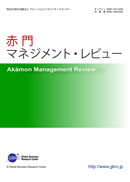
- |<
- <
- 1
- >
- >|
-
Chikashi Kishimoto2016Volume 15Issue 12 Pages 569-646
Published: December 25, 2016
Released on J-STAGE: February 25, 2017
JOURNAL FREE ACCESSThis study focuses on the Taiwanese Semiconductor IC (integrated circuit) industry, especially, the IC design sector (called “fabless”), and examines its development situation and the general competitive strategy of Taiwanese IC fabless companies. In addition, this paper also investigates the rise and fall of major fabless companies and the factors which affect it. First, a detailed analysis is made on various factors which compose the general competitive strategy of Taiwanese IC fabless companies, for example, vertical division of labor and specialization, second-mover strategy, and other derivative features including the inclination for standard products (not customized products), close interaction with main customers during the product development process, “total solution”, selection and focus, and so on. Then, this paper tries to offer an easy-understandable and systematic picture of the relationship of these various factors and their contribution to competitive advantages. For this purpose, this study adopts the method of describing the competitive strategy “as a story” proposed by Prof. Ken Kusunoki, Hitotsubashi University. Also a contrast is made with the story of the competitive strategy of Japanese semiconductor companies which has gone downhill recently. As a result, the story of Taiwanese fabless companies shows many features of “a good story”. On the other hand, the story of Japanese companies even shows the possibility of strategic failure rather than success. Second, in consideration of a variety of strategies and growth paths among Taiwanese companies, this paper offers case studies of ten major fabless IC companies, through which the detailed story of each company is described, then the factors which explain the difference among companies are examined. As a result, several important factors are found out including whether a fabless company can catch a market of main stream application products of the times, whether it can dexterously extend its existing core technology to related application products by making good use of technological synergy effect, and whether it has its own peculiar advantages in product technology and marketing, not just relying on “me too” behavior.
View full abstractDownload PDF (1443K)
-
Technical Notes on Dutton and Dukerich (1991)Yoshiaki Yamashiro2016Volume 15Issue 12 Pages 647-654
Published: December 25, 2016
Released on J-STAGE: February 25, 2017
JOURNAL FREE ACCESSThis paper reviews Dutton and Dukerich (1991) which is famous for Organizational Identity theory and summarizes their research method for using organizational identity as explanatory variables. Their research method are composed of (1) organizing organizational history in time-series, (2) identifying organizational identities with contents analysis, and (3) correlating organizational identities with organizational interpretations, emotions and actions.
View full abstractDownload PDF (463K)
-
[in Japanese]2016Volume 15Issue 12 Pages 655-658
Published: December 25, 2016
Released on J-STAGE: February 25, 2017
JOURNAL FREE ACCESS -
[in Japanese]2016Volume 15Issue 12 Pages 659-662
Published: December 25, 2016
Released on J-STAGE: February 25, 2017
JOURNAL FREE ACCESS
- |<
- <
- 1
- >
- >|